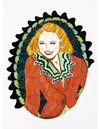Artist Statement
A quote by the famed but largely forgotten actress, Luise Rainer, has inspired decades of my art;
Some very beautiful things get lost and forgotten.
I am drawn to portray veneration of the lost and forgotten woman.
In my series Starlet, I’ve recreated obituary photos of women who were once starlets, entirely in butterfly wings. In these iridescent cameos, the wings represent the fleeting nature of beauty and glamour.
Surely unique to the Los Angeles Times, this newspaper often prints lengthy obituaries with large photographs of women who once were starlets. Regardless of how small her contribution to film, the newspaper can’t seem to resist a headshot of a woman in all her ephemeral beauty. The starless seduction continues even in death.
Georgine Darcy, for instance. Georgine was “Miss Torso” in Hitchcocks “Rear Window”, her only notable role and one in which she’s seen only from the neck down—was given a half page obituary. Candy Barr, a stag film star, recieved an 85 inch obituary with four photographs while on the same day, John Magee, the chemist who worked alongside Robert Oppenheimer on the Manhattan Project (“one of the most celebrated and controversial projects in the history of science”) was allotted a mere five inches with no photo.
In light of the current watershed moment coming to light about women who have endured sexual harassment, abuse and assault by men, it makes me wonder what abuse these starlets might have endured. We all know the legend of the “casting couch” no doubt based in plenty of fact. Was there a “Harvey Weinstein” in their life? If so, how did it affect their career? It’s possible that these are the actresses who rebuffed a powerful studio executive who then sabotaged their career.
In my upcoming collaboration with renowned jazz pianist and composer, Bobby West, I am creating a large butterfly text based piece to accompany his original composition based on the life and lynching of young and pregnant Mary Turner in Alabama in 1918. Mary Turner represents the 148 black women, out of 3,446 total African Americans lynched between the late 1800s to the early 1900s.
With my company, Ethio Sky, I work with female artists and artisans in Ethiopia to provide them a path to income and to preserve their art.
http://www.ethiosky.com/
A quote by the famed but largely forgotten actress, Luise Rainer, has inspired decades of my art;
Some very beautiful things get lost and forgotten.
I am drawn to portray veneration of the lost and forgotten woman.
In my series Starlet, I’ve recreated obituary photos of women who were once starlets, entirely in butterfly wings. In these iridescent cameos, the wings represent the fleeting nature of beauty and glamour.
Surely unique to the Los Angeles Times, this newspaper often prints lengthy obituaries with large photographs of women who once were starlets. Regardless of how small her contribution to film, the newspaper can’t seem to resist a headshot of a woman in all her ephemeral beauty. The starless seduction continues even in death.
Georgine Darcy, for instance. Georgine was “Miss Torso” in Hitchcocks “Rear Window”, her only notable role and one in which she’s seen only from the neck down—was given a half page obituary. Candy Barr, a stag film star, recieved an 85 inch obituary with four photographs while on the same day, John Magee, the chemist who worked alongside Robert Oppenheimer on the Manhattan Project (“one of the most celebrated and controversial projects in the history of science”) was allotted a mere five inches with no photo.
In light of the current watershed moment coming to light about women who have endured sexual harassment, abuse and assault by men, it makes me wonder what abuse these starlets might have endured. We all know the legend of the “casting couch” no doubt based in plenty of fact. Was there a “Harvey Weinstein” in their life? If so, how did it affect their career? It’s possible that these are the actresses who rebuffed a powerful studio executive who then sabotaged their career.
In my upcoming collaboration with renowned jazz pianist and composer, Bobby West, I am creating a large butterfly text based piece to accompany his original composition based on the life and lynching of young and pregnant Mary Turner in Alabama in 1918. Mary Turner represents the 148 black women, out of 3,446 total African Americans lynched between the late 1800s to the early 1900s.
With my company, Ethio Sky, I work with female artists and artisans in Ethiopia to provide them a path to income and to preserve their art.
http://www.ethiosky.com/
Lori Precious







